







IPCS |
International Programme on Chemical Safety |
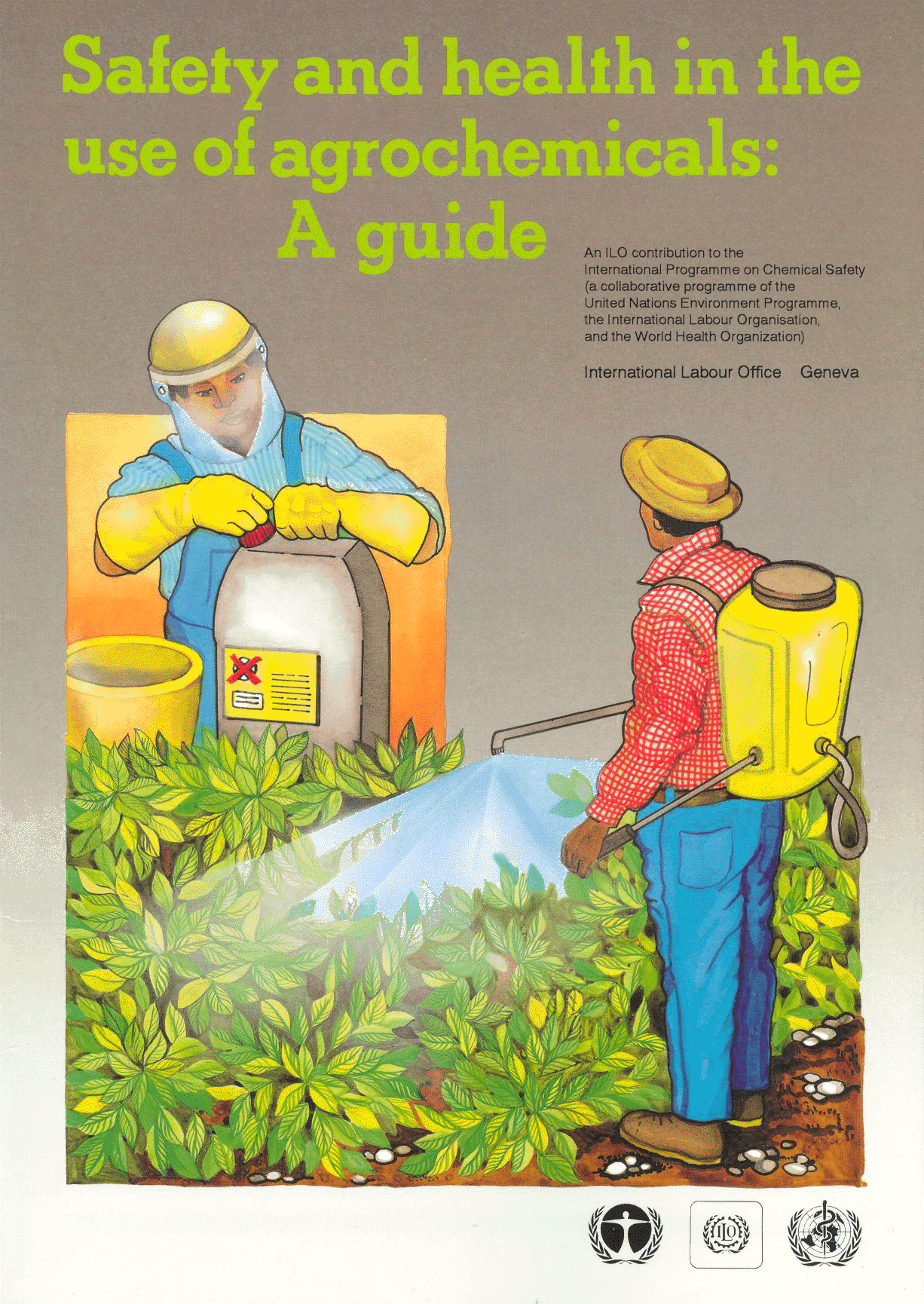 Safety
and Health in the Use of Agrochemicals
Safety
and Health in the Use of Agrochemicals
An ILO contribution to the
International Programme on Chemical Safety
(a collaborative programme of the United Nations Environment Programme the International
Labour Organisation and the World Health Organization)
Manufacturers have a major role to play with regard to safety and health in the use of agrochernicals. There is a trend towards developing less toxic but effective products and improved techniques in packaging, and steps are being taken to ensure that agrochernicals advertised and marketed also contain essential information on safety precautions. These are some of the key roles of manufacturers.
4.1.2. Development and packaging
Agrochernicals are produced from either naturally occurring materials or from substances developed in laboratories. Natural products such as lime, rock phosphate and guana are extracted and processed ready for application as fertiliser to the soil. Laboratory work is performed to determine the concentration of the active ingredient so that the user can calculate the rate of application.
Most synthetic agrochernicals are developed on a laboratory scale and are investigated for many years, in some cases before manufacture on a commercial scale. Rigorous tests are required at each stage of development.
Figure 48 describes the development of a typical agrochernical. Apart from testing for its effectiveness as an agrochemical, tests are carried out on agrochernicals to determine its toxicity before marketing. The user should remember, therefore, that agrochernicals may be used safely by carefully following the instructions on the label or accompanying information sheets.
Having developed a pesticide in the manner described, the manufacturers, formulators and suppliers have other important duties to perform before marketing their product. These include the following:
- has been investigated to determine hazardous properties and the hazards it would present when used as an agrochemical;
- is packaged in accordance with international or national regulations and that the containers will withstand transport and handling without leaks;
- is labelled so as to provide essential information in the language of the region and according to international or national regulations; and that a chemical safety data sheet is provided along with the package to employers and others who request it;
- is provided with an information sheet if it is notlabelled.
Labelling, packaging and supply of information and data sheets have already been dealt with in this guide.
4.1.2. Advertising and marketing of agrochemicals
The agrochernical market is very competitive and advertising is an important part of commercial success. Users need to be reminded of this fact. At the same time they should recognise that those who advertise and market different products have a duty and responsibility to provide essential information on the hazards they present and safety precautions to be observed. Users should find an opportunity to discuss with suppliers, agricultural extension workers and other community leaders the following merits in advertisements. Advertisements should contain statements or visual presentation which give precise and explicit information to the buyer, in particular with regard to the safety of the product, its nature, composition or suitability for use, or official recognition or approval by the competent authority. Safety and health should not be compromised for commercial success. Advertising or promotional material should draw attention to the appropriate warning phrases and symbols.
4.2. Role of government agencies
More than one government department or agency is usually responsible for the management of agrochernical supply and use. The various responsibilities include registration and approval; transport, marketing and sale; safety and health at work; public health aspects and environmental impact. Product registration, regulation and enforcement are important aspects of government action in safety and health in the use of agrochemicals.
The registration, evaluation and approval of an agrochernical is necessary to control its use and to ban or restrict the use of other agrochernicals which may be unsafe.
Users may not be familiar with the detailed procedure for government approval of a product before it is marketed. However, they should be aware that such a procedure exists in many countries (figure 48). Knowledge and information about the national agrochernical registration authority would be an advantage. This government authority or agency should also have the capability to provide information about training, first aid and arrangements for the safe disposal of waste. The FAO Guidelines for the registration and control of pesticides (Rome, 1985) give further details.
4.2.2. Promulgating regulations
Regulations are legal instruments made by governments to control various activities. They set standards, provide for enforcement and impose penalties of fines or imprisonment for those who fail to comply.
Users should know the national regulations and comply with them. If they contravene the law, penalties will be imposed for each contravention. In general, regulations on the use of agrochemicals may prescribe:
Users should remember to study the national regulations before starting to use agrochemicals. Further information on international action is available in the FAO Guidelines for legislation on the control of pesticides (Rome, 1989).
4.2.3. Provisions for enforcement and advisory services
Enforcement is the action necessary to ensure compliance with the law. Safety and health laws and regulations are prescribed to protect workers, including self-employed persons such as farmers, against hazards at work. Therefore, many people might be persuaded to comply once they have been properly informed. Consequently, a first step of the law-enforcing authority is to provide advice and publicity on what the law is about, what it seeks to achieve and what people have to do to comply with it. Agrochernical users should always seek the advice and guidance of enforcement authorities, who should perform their advisory role seriously and effectively.
Enforcement is carried out by agricultural inspectors. Inspectors have the power to: enter agricultural land or buildings; make inquiries, take samples and carry out inspections; investigate any accident or dangerous occurrence; and such other actions as may be specified. Enforcement authorities also have the important task of providing technical advisory services to community leaders, employers and workers and their organisations (figures 49 and 50).
Figure 49. Enforcement authorities should provide technical advice on safety and health in the use of agrochemicals

Figure 50. A community leader
receives information and documentation
from an enforcement/agricultural extension officer
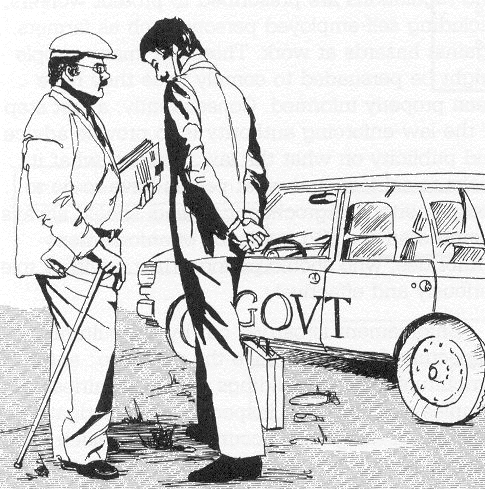
4.2.4. International exchange of information
There are international procedures for exchange of information on hazardous agrochemicals. Prior informed consent is an agreement to ensure that countries importing agrochemicals, particularly pesticides, are notified about any product which may be banned or severely restricted in the exporting country. The purpose of this notification is to give the competent authorities the opportunity to assess the risks associated with the agrochemicals, and to make appropriate decisions as to their importation and use. The arrangement is particularly helpful to developing countries who may unknowingly import a dangerous agrochemical and allow its use in circumstances where there is a serious risk to health.
Retailers and their assistants need to recognise the significance of providing information on safety and health in the use of agrochernicals to all customers. In addition, they should be familiar with safety provisions in the transport, storage and handling and use of agrochernicals, and disposal of empty containers and waste.
A retailer of agrochernicals should:
Further details are available in the FAO Guidelines on retail distribution of pesticides with particular reference to storage and handling at the point of supply to users in developing countries (Rome, 1988).
4.4. Role of employers and their organisations
Employers could be managers of plantations, farmers or others who employ workers in the use of agrochemicals. They should:
- choosing the appropriate equipment and machinery for work with agrochemicals;
- instructing all workers, particularly those who are new or functionally illiterate, about the hazards and the safety precautions;
- effective supervision of all agrochemical operations to ensure correct operation and prevent any hazards that may result from lack of knowledge or experience of workers;
- maintenance, repair and periodic inspection of equipment and machinery and workplaces;
- complying with safety and health regulations and safe working practices.
Employers, in discharging their duties, should co-operate with workers and their representatives with regard to safety in the use of agrochemicals at work. Employers' organisations such as planters' organisations and farmers' associations could promote safety and health in the use of agrochemicals by various activities such as safety and health campaigns and competitions, and publicity programmes. They could also take a leading role in awareness-creating activities such as organising seminars and workshops with community leaders, agricultural extension workers, schoolteachers and primary health-care workers (figure 51).
Figure 51. Training workshop at a
community
centre
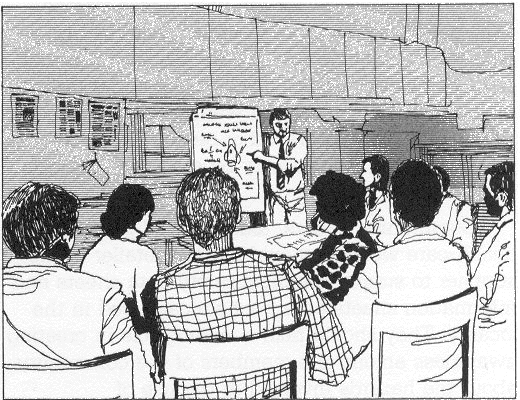
4.5. Role of workers and their organisations
Workers should co-operate with their employers in carrying out their duties and should comply with all procedures and practices relating to safety in the use of agrochemicals at work. They should note and follow the instructions given by the manufacturer, supplier, employer or supervisor. Workers should take all reasonable steps to mintnise risk to themselves, other workers, employers, farm animals, crops and the environment. Additionally, they should:
The use of agrochernicals has implications for the public as well as for the user. Areas treated with pesticides may be unsafe to walk through; wild fruit in hedgerows may be unsafe to eat and agrochernicals may pollute waterways and the environment. Users should warn the public about the farrr~dand to be sprayed or recently sprayed with agrochemicals, if necessary by erecting a warning sign.
Community leaders, teachers and primary health-care workers should ask the retailer or the supplier to supply chemical safety data sheets and information sheets on agrochernicals used in the locality. They should take a leading role in creating awareness among the members of the community about the hazards involved in the use of agrochemicals and in giving necessary instructions to users on their safe use (figure 52). Community leaders could arrange for regular discussions and group meetings in schools, places of worship or community centres, providing for exchange of information on safe practices.
The public should remember:
Figure 52. Community leaders have an important role to play in educating farmers
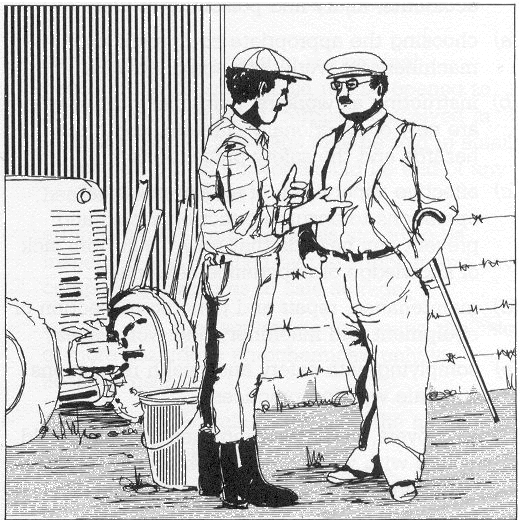
Figure 53. Prevent children from
playing in treated
areas
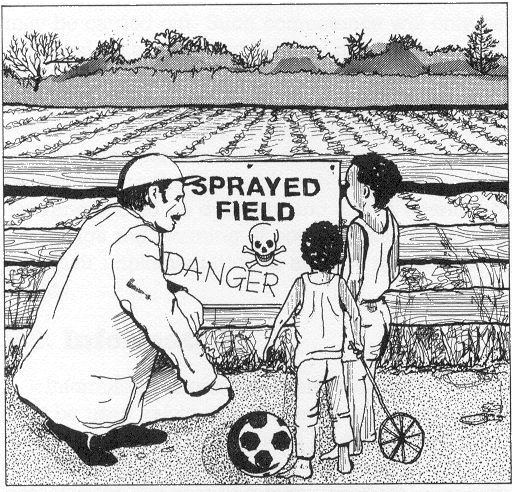
to obtain prompt medical attention for anyone who handles agrochernicals and becomes ill, remembering to mention the name of the agrochernical used; not to use empty agrochernical containers for household purposes - they may contain small amounts of poison that could kill people.
There will be other times in which the circumstances of agrochernical use are unusual or specific to a particular situation. The public should be guided by the general precautions described and adapt them where it appears necessary.
Discussion and activities
1. List how the actions of each of the following persons or groups would help you in ensuring safety and health in the use of agrochernicals: